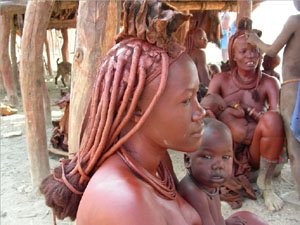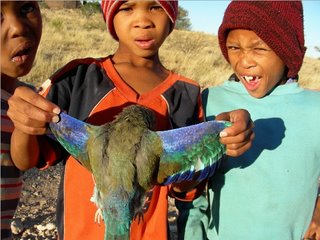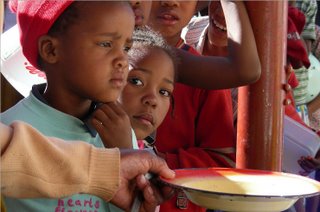Journeys to the North – May, 2006
This trip came to pass in a very Namibian way; half by chance, half as result of randomness and a few added sprinkles of complete luck. I am almost convinced that in Nam, a lack of these ingredients, even a bit of one, results in inevitable stagnation. It’s true…
So, I had been mulling over the idea of heading north for some months leading up to the May break, but couldn’t fully grasp how to go about an undertaking of the task. Sometime in April, not long after I had moved out of the hospital, (my first months here in A town I was shacked up in a hospital room. I kind of enjoyed it actually. Made a lot of friends and saw the medical problems and hazards associated with this area first hand; not the stuff good dreams are made of though) I made a turn to visit my good friends, Sylvia and Meme (a respectful term for older women, Oshiowombo) Shikongo -- the matron of the Aranos Hospital. So we were casually chatting, one thing led to another, I mentioned I wanted to see the north, Meme Shikongo said that she is from “outside Oshikati”, and that she would love to have me up to her family’s homestead. Rock.
So all was set. In May we hiked together up to Windhoek, collected her son and a small child that I think was her daughter’s, not sure really, and caught a combie destined for Oshikati. Ha, not so easy. After 10 or so hours in a minibus, packed not unlike sardines -- but more like 26 people with screaming hungry kids and the occasional piece of wildlife that we kept stopping for every once in a while to collect after ramming, presumably for the driver’s dinner, but who knows – we actually ended up getting off about 10km short of Ondangwa, in Onjena. Meme Shikongo had a brother in the village, and after a short bokkie ride into the middle of dead of the night nowhere, we arrived at his homestead.
The North, in Owomboland at least, is crazy different from the red dunes of Aranos. The landscape is noticeably marked by beautiful tall palms, mopanie trees, mud huts and homesteads, and gleaming ponds/watering holes, where women and children could be seen at anytime of day fishing with traditional baskets and sticks. The area is also afflicted by a plague of cucca shops and shabeens, or bars operating illegally with out licenses and usually serving homebrews. We for sure have these in Aranos as well, and though they pose a huge problem in terms of health, and just about every part of life you can think of, the proliferation of these places in the north is off the charts compared to the south. I think this is due to several reasons: one, most everyone in this area grows there own crops and are largely self sustained; as a result, any money that does come in is mostly spent engaging in the national pastime, drinking – two, most of Nams 2mil population is found in the north; I think the south seriously has the lowest population density in the world… Crazy.
Onjena marked the beginning of a week and a half of near starvation. I mean, they gave me food, and I was super thankful no doubt, but it took a lot of getting used to. The main dish, which is served at every meal, is mahongu porridge. It really isn’t “that” bad -- it’s thick and you eat it with your fingers and has an odd kind of bland taste. The problem is that it’s thrashed in a pit dug out of clay; the result being that there are grains of sand in the stuff. I discovered this little talked about fact while eating my first meal with the family. It was dinner by candlelight, so I couldn’t see a thing, and over this porridge was poured some unidentifiable meat and gravy like stuff that smelled like intestines. I had it in my mind to be strong and eat everything, because that’s what you do right. So, everyone is quietly eating, and I’m thinking “ok, big bites, get it down, no worries.” Then I scooped up a bunch of the stuff with my fingers, and I chomp down. CRUNCH CRUNCH... A terrifying moment of enamel stripping pain produced an unavoidable shockwave that passed around the table. Everyone was starring at me, and I was doing my best to control my face from contorting and at the same time trying not to spew. No one told me there was sand in the stuff. Totally unexpected man! So then of course everyone was like, “you don’t like? Whats wrong?” And to make it worse, it was obvious that the addition of intestines was an occasion reserved for guests and what not. Gesh. But I made it through without sloshing, so I was happy and I suppose everyone else was too. The trick is learning to chew with your tongue, just in case you find yourself in a similar spot eh.
Anyway, we stayed at the brother’s place for two nights. The full day that I had there, I spent mostly fishing with the kids and trying to learn the polite customs and what not to do – mostly by trail and a ton of error. From his place, we headed to Oshikati in a cab -- I was amazed that you could take a cab from anywhere to anywhere for nothing up there – and from there we headed to Meme Shikongo’s homestead.
So up to this point in the travels, I had the impression that Meme Shikongo’s place was like right outside of Oshikati. I should have known better. In reality, her homestead was outside of Uutapi, often spelled Outapi, which is halfway between Oshikati and Ruacana. No love lost though, I was in heaven. Staying on super traditional homesteads along the Angolan border, I couldn’t have asked for more; though a pizza would have been nice.
Almost everyday I hung out with the boys. We went out hunting and fishing all across the countryside. No Owombo boy is complete with out his slingshot in his back pocket, thought they call them caterpillars. They wield these imprecisely honed weapons so that while walking through the fields or heading to the fishing spots, one can take endless potshots at anything suspected to be a bird, or to be breathing. Perhaps one in a hundred of these gleeful, yet very serious, assassination attempts actually pan out and when the odd shot does make its mark, a mid-day snack is prepared. Needless to say, I had a really good time hanging out with the guys. It was really amazing to me that we could go out in the morning and stay out for most of the day, just eating the things that we came across in the fields, stuff off trees, berries, stuff off the ground, birds and what not. On the flip side of this, I often felt really bad that the girls of the homestead didn’t get to share in these pleasures of play. Instead they labored in the homestead, pounding mahangu, preparing food, washing, cleaning, etc. It is a very gender-role driven culture, more so than the predomatly Nama culture of the south where I am, and at times can be difficult to deal with.
I spent a few days just hanging out with the kids, learning how to pound and prepare mahongu with the family, and digesting the new and interesting culture. At night I would sit with the men and drink the traditional brews: mainly just oshikundu, engiga, alawende, and empwaka (I’m guessing as to the spelling, but they were really good). It was a bit of a shock, and kind of a laughing point, for most people that a white guy would drink the traditional drinks and actually enjoy them; something that appariently happens very little, primarily due to the lack of white people in the area. I enjoyed every minute of my time during those days, even though it was exhausting.
On the fourth or so day, I decided to push my luck a bit more and attempt a quick day trip to Ruacana Falls; a mere 80km jump on a map, yet it was a road full of unexpected adventure. To get a lift, I had made an inquiry to one of the ladies on a nearby homestead about the possibilities of going, and she said she knew someone’s cousin who also wanted to go, and he knew some person who could “organize” for us a lift. The word “organize” is used for a lot of arrangements and various random things, and it’s almost always super sketch. For example, the commonly hear phrase “I will organize for you a woman” always makes me a little uncomfortable. So anyway, this lady “organizes” for us a car on the conditions that she can go too; and so we head off for Uutopi in the early morning to catch the ride. When we get into town, the lady and the unknown cousin, lead me to a bar, and proceed to order a round of Taffles. So I’m thinking, why did we rush to get here? However, one thing I’ve learned is to just relax and let things unfold, chances are that you eventually get to where you are trying to go; and if you don’t, you might as well have a few beers while you wait. So, after 3 hours of “he’s on his way” and watching two complete strangers get smashed, a car drives up and indicates that he’s our mystery driver. So we seemingly started on our way towards the falls.
For about forty km everything was gravy; we were on our way and nothing could stop us, I was happy. That’s when a goat took his decided to take a chance with fait, and leapt onto the tar road in front of us; offering its soul to the god of random accidents. Bam… One dead goat, and a broken headlight. Having never hit a goat in Northern Namibia before, I was largely unaware to the ritual that follows. It involved however, about 2 hours of driving around on what could pass as dirt roads, but would be more adequately classified as goat paths, through villages that are on no map to find the goats owner. The goat during all of this was not so carefully laid upon the impromptu alter between the back windshield and the spoiler, as the trunk was full of cases of empty beer bottles. Eventually we found the owner sitting outside a small hut in the middle of nowhere. We all stood around and starred at the goat. A few people had intense conversations, though I suspected that the were retelling the tale of the heroic attempt on the part of the goat come in-between some white guy and a trip down the road, which they didn’t quite understand. I was amused.
Eventually we did get back on the road, and made it to the Angolan border crossing without further incident.
Running out of time to type so I will rap it up quick. Border was crazy cool. Caught a goat by the horns, thus becoming a “man” in the eyes of some Himbas. The falls were great. An amazing trip.
The End…






 That night the jackals returned, and made off with the oatmeal out of the tent. This was a sad moment as we didn’t have much to eat. Who knew that jackals had a thing for the oats. Also during the night, a herd of oryx , or gemsboks, made their way through out camp. I awoke to what sounded like horses galoping through, and when I opened my eyes, a giant oryx stood not 4 feet away, towering over me. I decided it was best not to move, and just watched as the beautiful animals made their way through.
That night the jackals returned, and made off with the oatmeal out of the tent. This was a sad moment as we didn’t have much to eat. Who knew that jackals had a thing for the oats. Also during the night, a herd of oryx , or gemsboks, made their way through out camp. I awoke to what sounded like horses galoping through, and when I opened my eyes, a giant oryx stood not 4 feet away, towering over me. I decided it was best not to move, and just watched as the beautiful animals made their way through. Lawrence Of Namibia.
Lawrence Of Namibia.

















